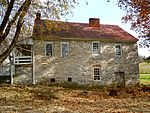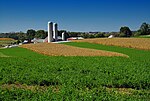Rex House
1729 establishments in PennsylvaniaHistoric House Museums of the Pennsylvania GermansHistoric house museums in PennsylvaniaHouses completed in 1729Houses in Lebanon County, Pennsylvania ... and 3 more
Houses on the National Register of Historic Places in PennsylvaniaMuseums in Lebanon County, PennsylvaniaNational Register of Historic Places in Lebanon County, Pennsylvania

The Rex House, also known as the Gemberling-Rex House, is an historic, American home that is located in Schaefferstown in Heidelberg Township, Lebanon County, Pennsylvania. Built in 1729 by early Pennsylvania German settlers, his structure is a 2+1⁄2-story, half timbered residence with originally scored plaster exterior and, currently, a horizontal wooden siding and a gable roof. It measures thirty-two feet by twelve feet and has gable end brick chimneys. Also on the property are a contributing smoke house, bake oven, stone foundation of a barn and outhouse and cistern.
Excerpt from the Wikipedia article Rex House (License: CC BY-SA 3.0, Authors, Images).Rex House
Heidelberg Avenue, Heidelberg Township
Geographical coordinates (GPS) Address Nearby Places Show on map
Geographical coordinates (GPS)
| Latitude | Longitude |
|---|---|
| N 40.298055555556 ° | E -76.293333333333 ° |
Address
Heidelberg Avenue 100
17088 Heidelberg Township
Pennsylvania, United States
Open on Google Maps








